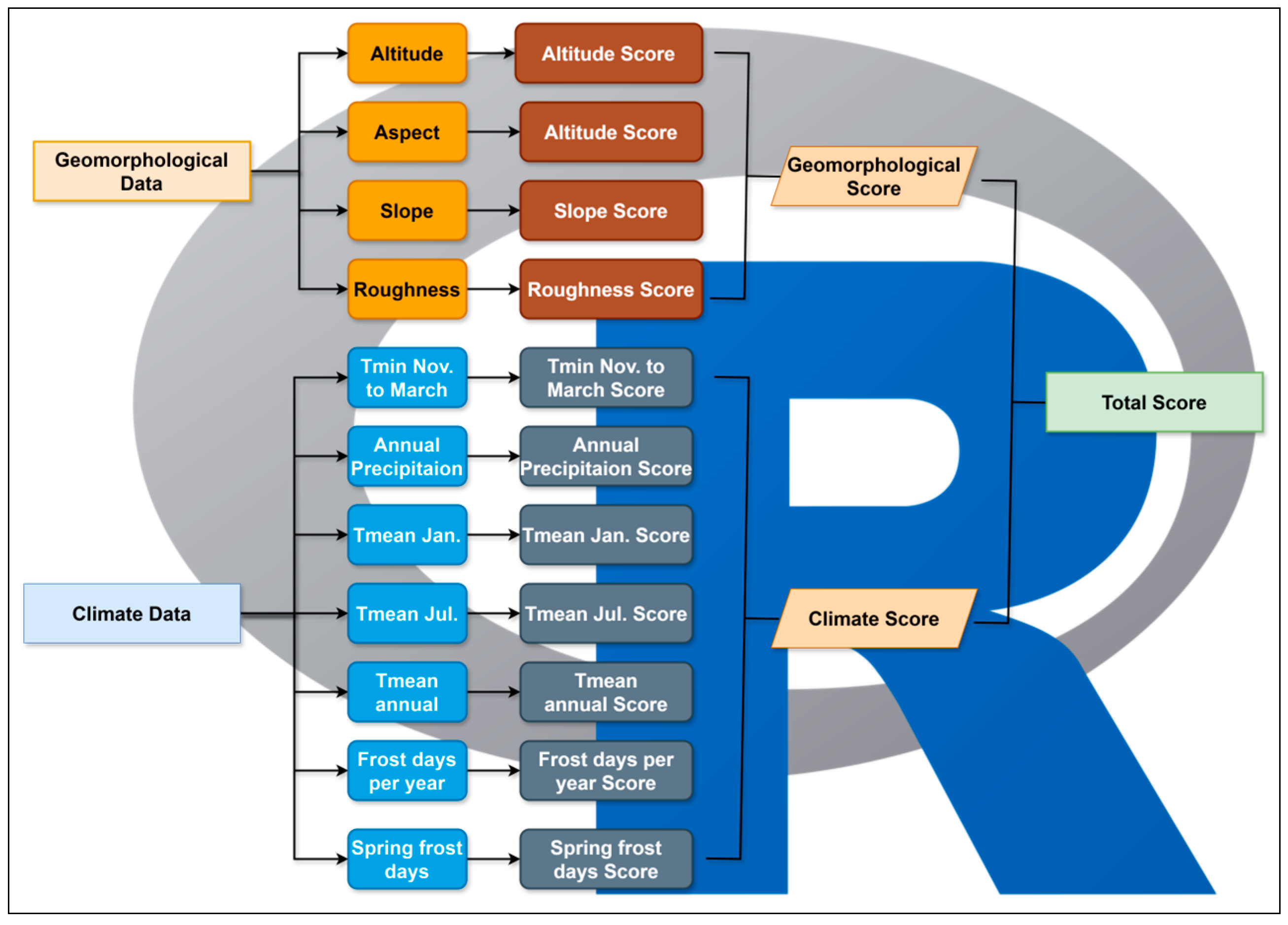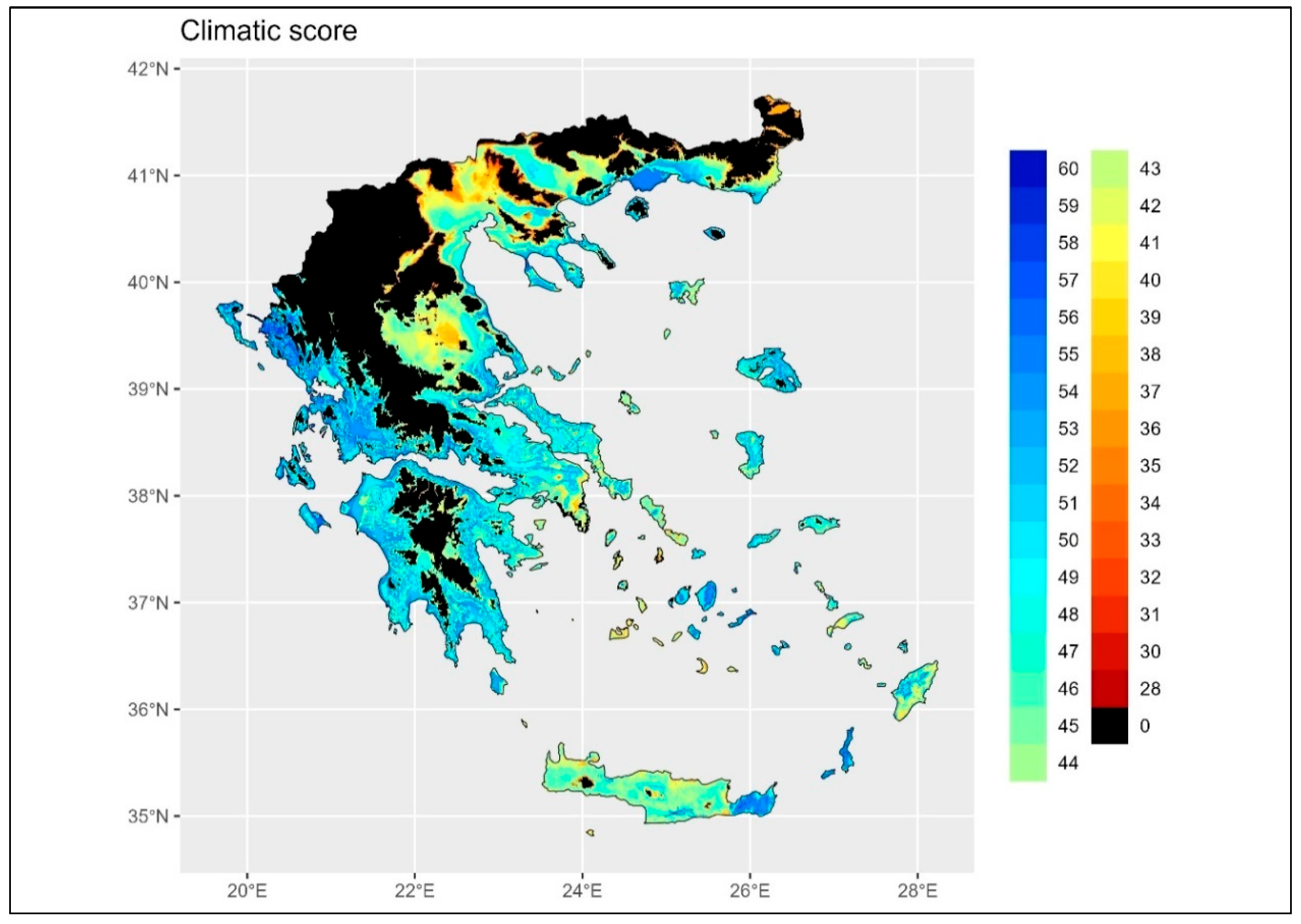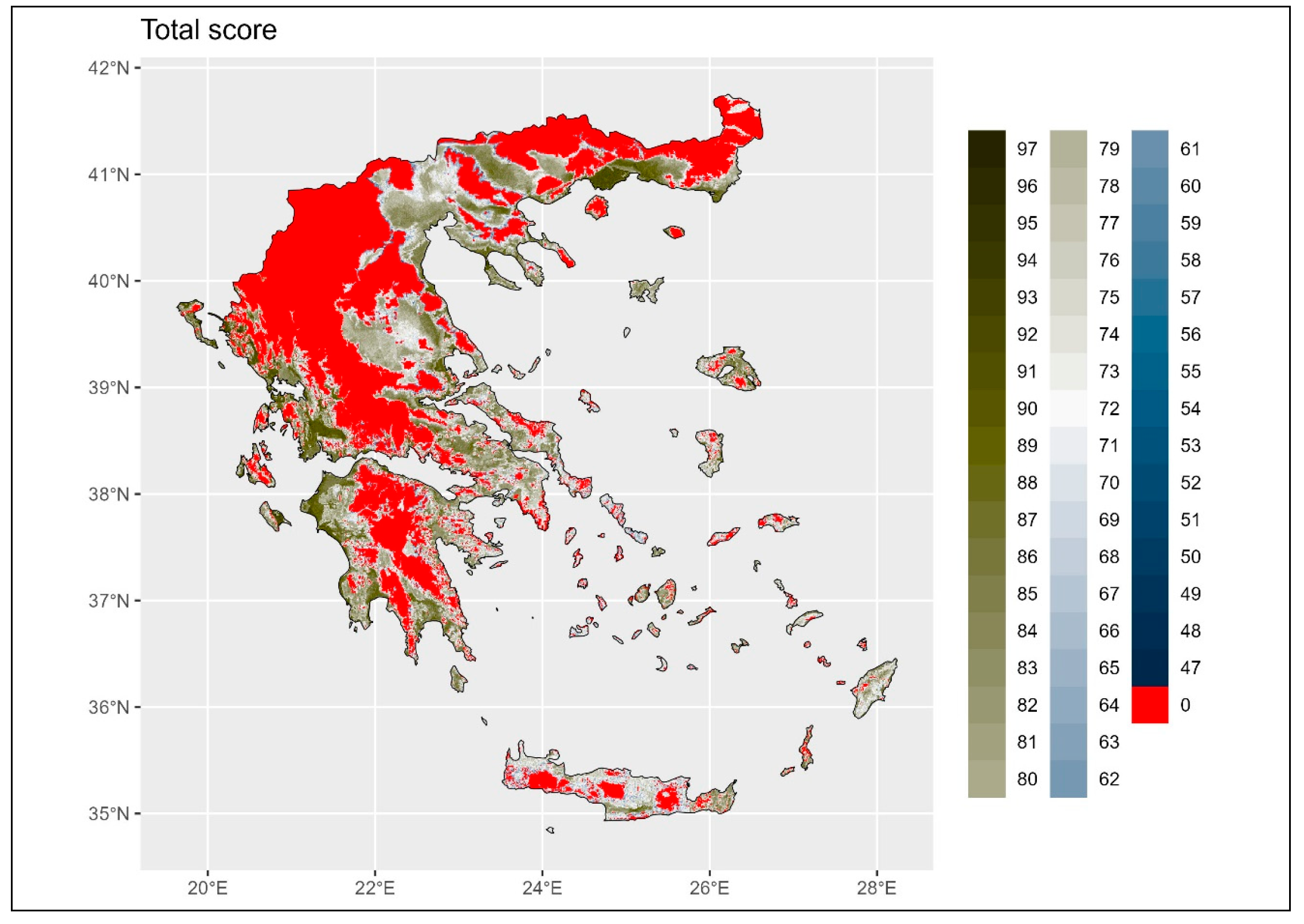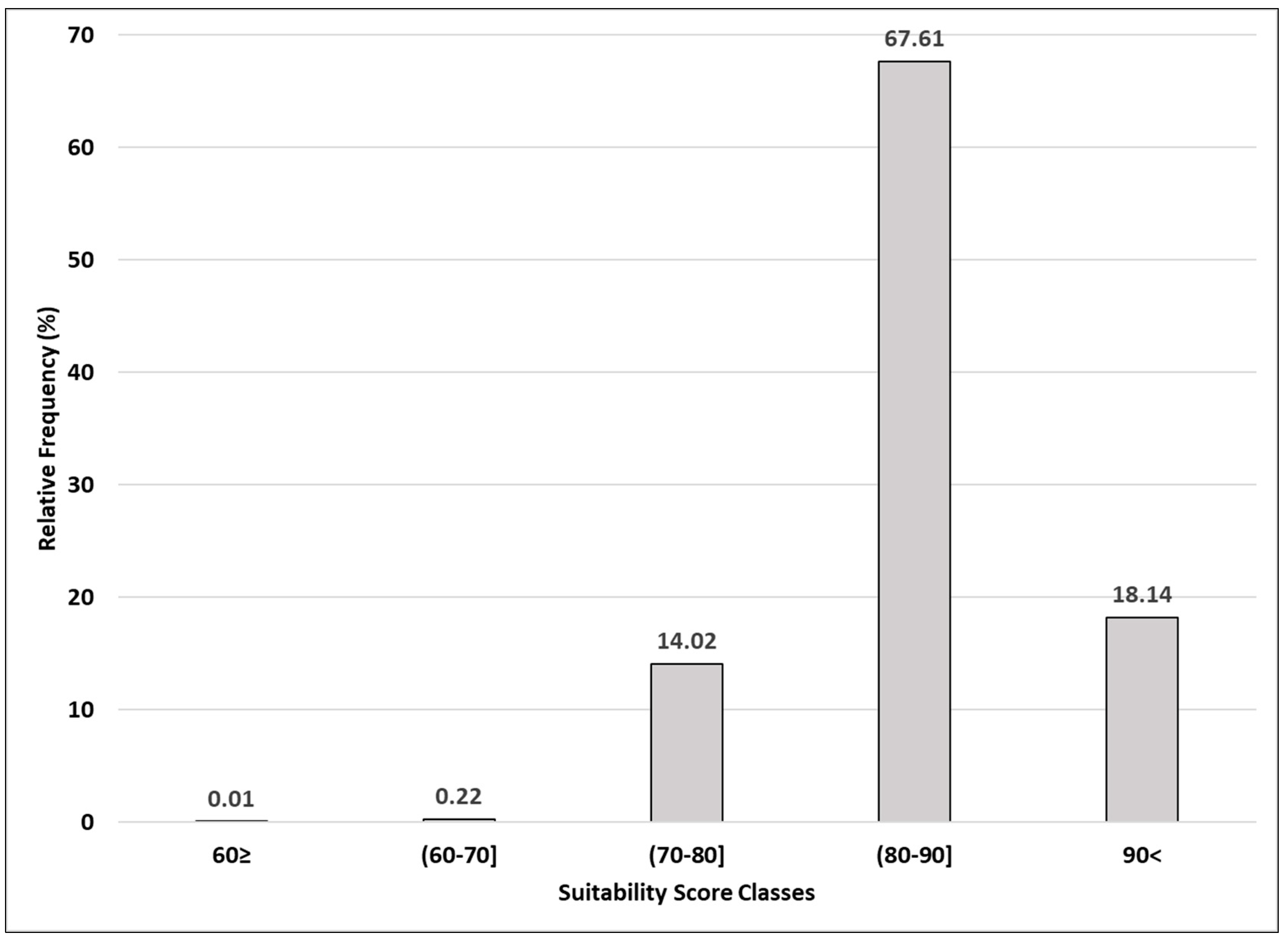A Climate Suitability Model for Olive Cultivation in Greece †
Abstract
1. Introduction
2. Materials and Methods
3. Results and Discussion
4. Conclusions
- Individually, the overall geomorphological and climate suitability for oliviculture is high in Greece. Overall, the olive suitability model may be characterized as efficient. The observed differentiations of the model-derived final suitability map from the recorded olive-growing areas over Greece may be justified by the application of limited climate and geomorphology components in the model. The present modeling procedure may serve as a tool for indicating suitable areas for the development of sustainable and productive olive culture. The model is defined by its simplicity, usability, and flexibility. As the modelling process is new, it requires evaluation and adjustments to improve accuracy. Additionally, incorporating environmental parameters affected by future climate change could generate an updated map of climatic suitability.
Author Contributions
Funding
Institutional Review Board Statement
Informed Consent Statement
Data Availability Statement
Conflicts of Interest
References
- Skiada, V.; Tsarouhas, P.; Varzakas, T. Preliminary Study and Observation of “Kalamata PDO” Extra Virgin Olive Oil, in the Messinia Region, Southwest of Peloponnese (Greece). Foods 2019, 8, 610. [Google Scholar] [CrossRef]
- Michalopoulos, G.; Kasapi, K.A.; Koubouris, G.; Psarras, G.; Arampatzis, G.; Hatzigiannakis, E.; Kavvadias, V.; Xiloyannis, C.; Montanaro, G.; Malliaraki, S.; et al. Adaptation of Mediterranean Olive Groves to Climate Change through Sustainable Cultivation Practices. Climate 2020, 8, 54. [Google Scholar] [CrossRef]
- Foscolou, A.; Critselis, E.; Panagiotakos, D. Olive Oil Consumption and Human Health: A Narrative Review. Maturitas 2018, 118, 60–66. [Google Scholar] [CrossRef]
- Fraga, H.; Moriondo, M.; Leolini, L.; Santos, J.A. Mediterranean Olive Orchards under Climate Change: A Review of Future Impacts and Adaptation Strategies. Agronomy 2021, 11, 56. [Google Scholar] [CrossRef]
- Petruccelli, R.; Bartolini, G.; Ganino, T.; Zelasco, S.; Lombardo, L.; Perri, E.; Durante, M.; Bernardi, R. Cold Stress, Freezing Adaptation, Varietal Susceptibility of Olea europaea L.: A Review. Plants 2022, 11, 1367. [Google Scholar] [CrossRef]
- Valverde, P.; Zucchini, M.; Polverigiani, S.; Lodolini, E.M.; López-Escudero, F.J.; Neri, D. Olive Knot Damages in Ten Olive Cultivars after Late-Winter Frost in Central Italy. Sci. Hortic. 2020, 266, 109274. [Google Scholar] [CrossRef]
- Papagiannaki, K.; Lagouvardos, K.; Kotroni, V.; Papagiannakis, G. Agricultural Losses Related to Frost Events: Use of the 850 hPa Level Temperature as an Explanatory Variable of the Damage Cost. Nat. Hazards Earth Syst. Sci. 2014, 14, 2375–2386. [Google Scholar] [CrossRef]
- Arampatzis, G.; Hatzigiannakis, E.; Pisinaras, V.; Kourgialas, N.; Psarras, G.; Kinigopoulou, V.; Panagopoulos, A.; Koubouris, G. Soil Water Content and Olive Tree Yield Responses to Soil Management, Irrigation, and Precipitation in a Hilly Mediterranean Area. J. Water Clim. Change 2018, 9, 672–678. [Google Scholar] [CrossRef]
- Rodrigo-Comino, J.; Senciales-González, J.M.; Yu, Y.; Salvati, L.; Giménez-Morera, A.; Cerdà, A. Long-Term Changes in Rainfed Olive Production, Rainfall and Farmer’s Income in Bailén (Jaén, Spain). Euro-Mediterr. J. Environ. Integr. 2021, 6, 58. [Google Scholar] [CrossRef]
- Ozalp, A.Y.; Akinci, H. Evaluation of Land Suitability for Olive (Olea europaea L.) Cultivation Using the Random Forest Algorithm. Agriculture 2023, 13, 1208. [Google Scholar] [CrossRef]
- Marques, P.; Pádua, L.; Sousa, J.J.; Fernandes-Silva, A. Advancements in Remote Sensing Imagery Applications for Precision Management in Olive Growing: A Systematic Review. Remote Sens. 2024, 16, 1324. [Google Scholar] [CrossRef]
- Rodríguez-Díaz, F.; Chacón-Maldonado, A.M.; Troncoso-García, A.R.; Asencio-Cortés, G. Explainable Olive Grove and Grapevine Pest Forecasting through Machine Learning-Based Classification and Regression. Results Eng. 2024, 24, 103058. [Google Scholar] [CrossRef]
- Kalamatianos, R.; Karydis, I.; Avlonitis, M. Methods for the Identification of Microclimates for Olive Fruit Fly. Agronomy 2019, 9, 337. [Google Scholar] [CrossRef]
- Thomidis, T.; Michos, K.; Chatzipapadopoulos, F.; Tampaki, A. Evaluation of Two Predictive Models for Forecasting Olive Leaf Spot in Northern Greece. Plants 2021, 10, 1200. [Google Scholar] [CrossRef]
- Navrozidis, I.; Alexandridis, T.; Moshou, D.; Haugommard, A.; Lagopodi, A. Implementing Sentinel-2 Data and Machine Learning to Detect Plant Stress in Olive Groves. Remote Sens. 2022, 14, 5947. [Google Scholar] [CrossRef]
- Kokkotos, E.; Zotos, A.; Tsirogiannis, G.; Patakas, A. Prediction of Olive Tree Water Requirements under Limited Soil Water Availability, Based on Sap Flow Estimations. Agronomy 2021, 11, 1318. [Google Scholar] [CrossRef]
- Kalfas, I.; Anagnostopoulou, C.; Manios, E.M. The Impact of Climate Change on Olive Crop Production in Halkidiki, Greece. Environ. Sci. Proc. 2023, 26, 69. [Google Scholar] [CrossRef]
- Bordoni, M.; Gambarani, A.; Giganti, M.; Vivaldi, V.; Rossi, G.; Bazzano, P.; Meisina, C. Present and Projected Suitability of Olive Trees in a Currently Marginal Territory in the Face of Climate Change: A Case Study from N-Italy. Sustainability 2025, 17, 1949. [Google Scholar] [CrossRef]
- Arenas-Castro, S.; Gonçalves, J.F.; Moreno, M.; Villar, R. Projected Climate Changes Are Expected to Decrease the Suitability and Production of Olive Varieties in Southern Spain. Sci. Total Environ. 2020, 709, 136161. [Google Scholar] [CrossRef]
- Cerasoli, F.; D’Alessandro, P.; Biondi, M. Worldclim 2.1 versus Worldclim 1.4: Climatic Niche and Grid Resolution Affect between-Version Mismatches in Habitat Suitability Models Predictions across Europe. Ecol. Evol. 2022, 12, e8430. [Google Scholar] [CrossRef] [PubMed]
- Beck, H.E.; Wood, E.F.; McVicar, T.R.; Zambrano-Bigiarini, M.; Alvarez-Garreton, C.; Baez-Villanueva, O.M.; Sheffield, J.; Karger, D.N. Bias Correction of Global High-Resolution Precipitation Climatologies Using Streamflow Observations from 9372 Catchments. J. Clim. 2020, 33, 1299–1315. [Google Scholar] [CrossRef]
- Bazzato, E.; Rosati, L.; Canu, S.; Fiori, M.; Farris, E.; Marignani, M. High Spatial Resolution Bioclimatic Variables to Support Ecological Modelling in a Mediterranean Biodiversity Hotspot. Ecol. Model. 2021, 441, 109354. [Google Scholar] [CrossRef]
- Fick, S.E.; Hijmans, R.J. WorldClim 2: New 1-Km Spatial Resolution Climate Surfaces for Global Land Areas. Int. J. Climatol. 2017, 37, 4302–4315. [Google Scholar] [CrossRef]
- Tanasijevic, L.; Todorovic, M.; Pereira, L.S.; Pizzigalli, C.; Lionello, P. Impacts of Climate Change on Olive Crop Evapotranspiration and Irrigation Requirements in the Mediterranean Region. Agric. Water Manag. 2014, 144, 54–68. [Google Scholar] [CrossRef]
- Büttner, G.; Steenmans, C.; Bossard, M.; Feranec, J.; Kolar, J. Land Cover—Land Use Mapping within the European CORINE Programme. In Remote Sensing for Environmental Data in Albania: A Strategy for Integrated Management; Springer: Berlin/Heidelberg, Germany, 2000; pp. 89–100. [Google Scholar]





Disclaimer/Publisher’s Note: The statements, opinions and data contained in all publications are solely those of the individual author(s) and contributor(s) and not of MDPI and/or the editor(s). MDPI and/or the editor(s) disclaim responsibility for any injury to people or property resulting from any ideas, methods, instructions or products referred to in the content. |
© 2025 by the authors. Licensee MDPI, Basel, Switzerland. This article is an open access article distributed under the terms and conditions of the Creative Commons Attribution (CC BY) license (https://creativecommons.org/licenses/by/4.0/).
Share and Cite
Droulia, F.; Charalampopoulos, I. A Climate Suitability Model for Olive Cultivation in Greece. Environ. Earth Sci. Proc. 2025, 35, 39. https://doi.org/10.3390/eesp2025035039
Droulia F, Charalampopoulos I. A Climate Suitability Model for Olive Cultivation in Greece. Environmental and Earth Sciences Proceedings. 2025; 35(1):39. https://doi.org/10.3390/eesp2025035039
Chicago/Turabian StyleDroulia, Fotoula, and Ioannis Charalampopoulos. 2025. "A Climate Suitability Model for Olive Cultivation in Greece" Environmental and Earth Sciences Proceedings 35, no. 1: 39. https://doi.org/10.3390/eesp2025035039
APA StyleDroulia, F., & Charalampopoulos, I. (2025). A Climate Suitability Model for Olive Cultivation in Greece. Environmental and Earth Sciences Proceedings, 35(1), 39. https://doi.org/10.3390/eesp2025035039






